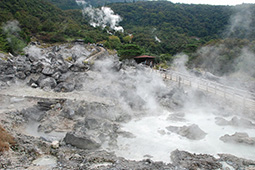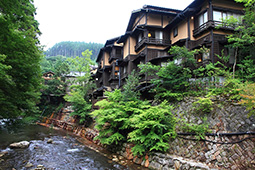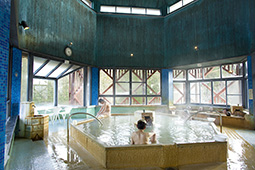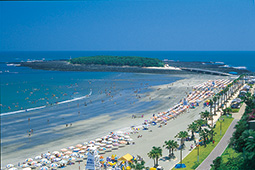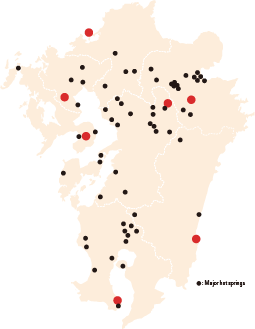Home > Highlighting JAPAN > Highlighting Japan October 2016 > Kyushu Calling
Highlighting JAPAN


Onsen Heaven
According to a report entitled “The Status of Hot Spring Bath Use” published by the Ministry of the Environment in 2014, about 9,500 (or about 35%) of Japan’s approximately 27,000 hot spring (or onsen) sources are located in the seven prefectures of Kyushu. The prefecture having the greatest number of hot spring sources in Japan is Oita Prefecture with 4,381, followed by Kagoshima Prefecture with 2,771. Both prefectures are in Kyushu. Onsen in Kyushu are located near the sea, by rivers, in the mountains or in locations with differing topographies and climates. Visitors to the island can therefore relax at a diversity of onsen. In this article, we introduce one onsen from each of the seven prefectures of Kyushu.
Shikanoshima Onsen (Fukuoka)
Rising out of Hakata Bank, the island of Shikanoshima is linked to the Kyushu mainland by a sandbar, and wafting up from under the island is the Shikanoshima onsen. The road leading out to the island is a single causeway known as the Naka-no-Michi, built above a sandbar with the sea on both sides. The high saline content of the hot water makes it especially effective in warming the body. Visitors to the island can take in the salt breeze, watch the evening sun descend into the sea and soak in the hot water.
Ureshino Onsen (Saga)
The hot water of Ureshino onsen is known for soothing the skin. Soaking into the slippery water, bathers find the qualities of the water cleansing away skin secretions and upon emerging find their skin left feeling smooth and silky. Specialities of the region include Ureshino green tea and Ureshino onsen boiled tofu (or yudofu) simmered in the alkaline water of the onsen. The water of the onsen breaks down the protein in the tofu, producing a particularly soft type of boiled tofu. Diners can enjoy it at Japanese-style ryokan inns or restaurants.
Unzen Onsen (Nagasaki)
Unzen Onsen is nestled amidst virgin forests on the slopes of Mount Unzen, a volcano located in the middle of the Shimabara Peninsula and the first of Japan’s volcanic areas to be included in the Global Geoparks Network. A volcanic area known as Unzen Jigoku (literally “Unzen Hell”) is located in the middle of the main string of volcanic baths, where the air is permeated with the odor of sulfur, and volcanic vents emit incessant clouds of white steam. In the Meiji (1868–1912) and Taisho (1912–1926) periods, the area was a health resort popular among foreigners, including Pearl Buck and Helen Keller.
Kurokawa Onsen (Kumamoto)
The onsen district of Kurokawa has been described as being much like a single inn, with the streets as hallways and the Japanese ryokan inns as the guest rooms. Some twenty quaint inns are nestled together along a stream in a mountain gorge, lending the scene a serene charm. The town is popular for the quaint way it blends with nature and for the warm hospitality of the locals. Especially popular are the “bath tickets,” which allow visitors to try open-air rotenburo baths at three inns. Also popular are “kappa tickets,” which allow guests to enjoy drinks as they walk through the neighborhood.
Nakayu Onsen (Oita)
The Beppu onsen and the Yufuin onsen are particularly well known among Oita Prefecture onsen, but the Nagayu onsen in the city of Taketa is lauded as the premier carbonated water hot spring in Japan. Famous for the beneficial properties of its waters, it has an old history and is included in the list of 100 top onsen in Japan. Effective whether imbibed or when soaked in, the waters of the Nagayu onsen are reputedly good for the heart, stomach and bowels. Many people come to Nagayu onsen for a “hot spring cure,” or to recover from illness by remaining there for an extended period.
Aoshima Onsen (Miyazaki)
Aoshima onsen bubbles up near the Aoshima seashore, a typical Japanese beach resort. The resort hotels have open-air baths with ocean vistas, enabling guests to sink into the water while gazing out over the open Pacific. The water of the Aoshima onsen is infused with hydrogen carbonate, which has the effect of cleansing and beautifying the skin.
Ibusuki Onsen (Kagoshima)
Ibusuki onsen is famous for its sunamushi (literally, “sand steam”) onsen. Here, guests do not soak in hot water but instead are buried in sand at the beach. Wearing a yukata (light robe), they lay face up on the sand. The onsen staff then cover them with sand. The onsen staff then cover them with sand. Though ordinary sand, it’s heated by the hot springs in the area and therefore becomes quite warm. When thoroughly covered with sand from the neck down, the whole body sweats profusely, stimulating the circulation. Sunamushi is therefore something like a kind of natural sauna.
© 2009 Cabinet Office, Government of Japan

